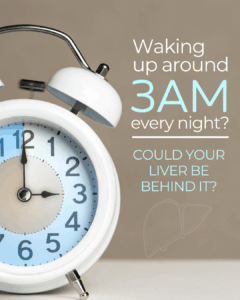🌙And What Your Body Might Be Trying to Tell You
Waking up between 2 and 4 AM, restless and alert, can feel draining night after night. You might lie awake feeling wired or anxious, watching the clock, and then spend the next day foggy, irritable, or craving sugar.
If blackout curtains, bedtime teas, or melatonin haven’t helped, there’s a reason. This pattern often signals an internal imbalance—not just poor sleep hygiene. The root cause may lie in your liver metabolism, overnight blood sugar balance, or stress hormone rhythms.
Let’s explore what’s really going on—and how to restore deeper, more restorative sleep.
🩸 1. Your Liver’s Late-Night Duty

Your liver follows its own circadian rhythm. Between roughly 1 and 3 AM, it’s busy processing hormones, detoxifying, and balancing blood sugar.
When it’s overloaded—by fatty buildup (MASLD), toxin exposure, late-night eating, alcohol, or even shift work—it can throw off your sleep cycle.
Research shows that people with metabolic-associated steatosis (MASLD) experience more frequent awakenings and less efficient rest. Meanwhile, chronic sleep deprivation can reprogram liver genes linked to metabolism and circadian timing.
When your liver’s rhythm is disrupted, your body’s rhythm follows—often waking you up in that 2–4 AM window.
🍯 2. The Blood Sugar Rollercoaster
Your body regulates blood sugar overnight through a careful balance of hormones. Two common patterns can cause wake-ups:
• Hypoglycemic wake-ups
If blood sugar dips too low (for example, from skipping dinner or unbalanced meals), your body releases adrenaline and glucagon to raise it. The result: a sudden jolt awake, maybe with heart palpitations, sweating, or a sense of unease.
• The dawn phenomenon
Before dawn, hormones like cortisol, growth hormone, and catecholamines signal the liver to release glucose. In people with insulin resistance, this can lead to early-morning spikes that trigger awakenings.
To identify your pattern, consider using a continuous glucose monitor (CGM). It helps you distinguish between rebound lows (Somogyi effect) and hormonal dawn surges.
☀️ 3. Cortisol and Stress Hormones
Healthy sleep depends on your cortisol rhythm syncing with your circadian rhythm. Ideally:
- Cortisol is lowest around midnight,
- Rises gently during the night,
- Peaks near sunrise to help you wake naturally.
When stress or late-night stimulation disrupts that pattern, cortisol may rise too early—between 2 and 4 AM—causing alertness or anxiety.
Experts now emphasize that cortisol’s timing is as crucial as melatonin’s production. When out of balance, it fragments sleep and reduces deep, restorative phases.
🧠 4. Conditioned Wakefulness
Our brains naturally enter lighter sleep stages later in the night. Over time, repeated awakenings can train your brain to wake up at the same time nightly—even when the original cause has passed.
Addressing both metabolic and behavioural triggers is key to breaking the cycle.
🌿 Practical Strategies for Deep, Silent Sleeps
Support your liver’s night-time work
- Eat dinner earlier and keep it moderate.
- Limit alcohol and processed foods.
- Focus on fiber, greens, and antioxidants.
Balance your evening glucose
- Include protein and healthy fat at dinner.
- Try a small snack (nuts, yogurt, or lean protein) if you suspect blood sugar dips.
- Avoid sugary or refined foods near bedtime.
Stabilize stress-hormone rhythms
- Dim lights and avoid screens one hour before bed.
- Practice calming breathwork or journaling.
- Keep a consistent sleep-wake schedule.
Honour circadian timing
- Aim for sleep before midnight.
- Get morning sunlight exposure to reset your internal clock.
Track if wake-ups persist
- Liver tests: ALT, AST, and GGT or ultrasound.
- Glucose data: CGM or overnight checks.
- Cortisol rhythm: salivary or serum testing.
Optimize light timing and food timing
Consistent mealtimes and daylight exposure strengthen your circadian system. Chrononutrition—eating in alignment with your body clock—can support both metabolism and sleep quality.
🌙 The Takeaways
Those 2–4 AM awakenings aren’t random—they’re your body’s whisper for balance. By exploring your liver health, blood sugar stability, and cortisol patterns, you can uncover the why behind your sleepless hours and guide your body back into its natural rhythm.
Instead of masking symptoms, address the deeper signals. With the right balance of nutrition, lifestyle, and hormone support, you can return to truly restorative sleep.
If your 2–4 AM wake-ups persist, our team can help you uncover the root causes and create a personalized plan for deeper rest.
References
- Reinke, H., & Asher, G. (2016). Circadian clock control of liver metabolic functions. Gastroenterology, 150(3), 574–580.
- Liu, S., Zhuo, K., Wang, Y., Wang, X., & Zhao, Y. (2024). Prolonged sleep deprivation induces a reprogramming of circadian rhythmicity with the hepatic metabolic transcriptomic profile. Biology, 13(7), 532.
- Schaeffer, S., et al. (2024). Significant nocturnal wakefulness after sleep onset in patients with MASLD. Network Physiology, Article.
- Schmidt, M. I., Hadji-Georgopoulos, A., Rendell, M., Margolis, S., & Kowarski, A. (1981). The dawn phenomenon: early-morning glucose rise implications. Diabetes Care, 4(6), 579–585.
- Potter, G. D. M., et al. (2016). Circadian rhythm and sleep disruption: metabolic consequences. Endocrine Reviews, 37(6), 584–608.
- Hirotsu, C., et al. (2015). Interactions between sleep, stress, and metabolism. Journal of Sleep Research, Article.
- Verdelho Machado, M. (2024). Circadian deregulation, MASLD, and chrononutrition. Nutrients, Article.
- Kovacs, M. (2025, August 6). Sleep mistakes that harm your health—and how to fix them tonight. Tom’s Guide (News article).
- Verywell Mind. (2025). Keep waking up at 3 a.m.? Here’s what your body might be telling you. (News article).
- Tom’s Guide. (2025). The surprising role cortisol plays in our sleep—and why it’s just as important as melatonin. (News article).


